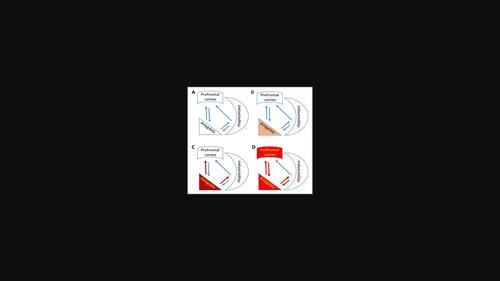当前位置:
X-MOL 学术
›
Eur. J. Neurosci.
›
论文详情
Our official English website, www.x-mol.net, welcomes your
feedback! (Note: you will need to create a separate account there.)
Intra-amygdala metaplasticity modulation of fear extinction learning
European Journal of Neuroscience ( IF 2.7 ) Pub Date : 2020-12-11 , DOI: 10.1111/ejn.15080 Rinki Saha 1 , Martin Kriebel 2 , Rachel Anunu 1 , Hansjuergen Volkmer 2 , Gal Richter-Levin 1, 3, 4
European Journal of Neuroscience ( IF 2.7 ) Pub Date : 2020-12-11 , DOI: 10.1111/ejn.15080 Rinki Saha 1 , Martin Kriebel 2 , Rachel Anunu 1 , Hansjuergen Volkmer 2 , Gal Richter-Levin 1, 3, 4
Affiliation

|
The amygdala is a key brain region involved in emotional memory formation. It is also responsible for memory modulation in other brain areas. Under extreme conditions, amygdala modulation may lead to the generation of abnormal plasticity and trauma-related psychopathologies. However, the amygdala itself is a dynamic brain region, which is amenable to long-term plasticity and is affected by emotional experiences. These alterations may modify the way the amygdala modulates activity and plasticity in other related brain regions, which in turn may alter the animal's response to subsequent challenges in what could be termed as “Behavioral metaplasticity.”Because of the reciprocal interactions between the amygdala and other emotion processing regions, such as the medial prefrontal cortex (mPFC) or the hippocampus, experience-induced intra-amygdala metaplasticity could lead to alterations in mPFC-dependent or hippocampus-dependent behaviors. While initiated by alterations within the basolateral amygdala (BLA), such alterations in other brain regions may come to be independent of BLA modulation, thus establishing what may be termed “Trans-regional metaplasticity.” In this article, we review evidence supporting the notions of intra-BLA metaplasticity and how this may develop into “Trans-regional metaplasticity.” Future research is needed to understand how such dynamic metaplastic alterations contribute to developing psychopathologies, and how this knowledge may be translated into promoting novel interventions in psychopathologies associated with fear, stress, and trauma.
中文翻译:

恐惧消退学习的杏仁核内元塑性调节
杏仁核是参与情绪记忆形成的关键大脑区域。它还负责其他大脑区域的记忆调节。在极端条件下,杏仁核调节可能导致异常可塑性和与创伤相关的精神病理学的产生。然而,杏仁核本身是一个动态的大脑区域,它具有长期的可塑性,并受情绪体验的影响。这些改变可能会改变杏仁核调节其他相关大脑区域的活动和可塑性的方式,这反过来可能会改变动物对随后挑战的反应,即所谓的“行为变可塑性”。因为杏仁核和其他大脑区域之间的相互作用情绪处理区域,例如内侧前额叶皮层 (mPFC) 或海马体,经验诱导的杏仁核内化生可能导致 mPFC 依赖或海马依赖行为的改变。虽然由基底外侧杏仁核 (BLA) 内的改变引发,但其他大脑区域的这种改变可能会独立于 BLA 调节,从而建立了所谓的“跨区域化生”。在本文中,我们回顾了支持 BLA 内化可塑性概念的证据,以及这可能如何发展为“跨区域化可塑性”。未来的研究需要了解这种动态化生改变如何促进精神病理学的发展,以及如何将这些知识转化为促进与恐惧、压力和创伤相关的精神病理学的新干预。
更新日期:2020-12-11
中文翻译:

恐惧消退学习的杏仁核内元塑性调节
杏仁核是参与情绪记忆形成的关键大脑区域。它还负责其他大脑区域的记忆调节。在极端条件下,杏仁核调节可能导致异常可塑性和与创伤相关的精神病理学的产生。然而,杏仁核本身是一个动态的大脑区域,它具有长期的可塑性,并受情绪体验的影响。这些改变可能会改变杏仁核调节其他相关大脑区域的活动和可塑性的方式,这反过来可能会改变动物对随后挑战的反应,即所谓的“行为变可塑性”。因为杏仁核和其他大脑区域之间的相互作用情绪处理区域,例如内侧前额叶皮层 (mPFC) 或海马体,经验诱导的杏仁核内化生可能导致 mPFC 依赖或海马依赖行为的改变。虽然由基底外侧杏仁核 (BLA) 内的改变引发,但其他大脑区域的这种改变可能会独立于 BLA 调节,从而建立了所谓的“跨区域化生”。在本文中,我们回顾了支持 BLA 内化可塑性概念的证据,以及这可能如何发展为“跨区域化可塑性”。未来的研究需要了解这种动态化生改变如何促进精神病理学的发展,以及如何将这些知识转化为促进与恐惧、压力和创伤相关的精神病理学的新干预。











































 京公网安备 11010802027423号
京公网安备 11010802027423号